Even after tackling all its challenges and achieving the “true ending” for Guacamelee!, I wanted more; more of its unique brawling action, more of its self-aware humor, and more platforming challenge. Guacamelee! 2 delivers all of that (and then some), but after 5 years between games, “more of the same” may not be what I actually wanted.
The game initially picks up at the very end of the first Guacamelee! with our hero, Juan, confronting and beating that game’s antagonist: Carlos Calaca. This brief section helps to setup the sequel (it’s even introduced as a kind of “Last Time On…” recap) while also doubling as a kind of tutorial. Once you beat Calaca and rescue your love interest, Lupita, the story jumps ahead 7 years. Juan and Lupita are now married with a couple kids and Juan is no longer the buff luchador he once was, i.e., you no longer have all the skills you did in the first game so you’ve got to get them all over again. Juan’s old mentor, Uay Chivo, suddenly appears to tell Juan that the “Mexiverse” (the Mexican multiverse) is in danger and he is the only one that can help. The new threat comes from Salvador, a man who also seems to wear a mystical wrestling mask and is pursuing three magical MacGuffins that will open the way to El Otramundo (the realm of the God of Time). Within that realm is Salvador’s ultimate goal: the Sacred Guacamole that will make whoever eats it all-powerful. It’s probably worth noting, too, that the three relics Salvador is chasing bear a striking resemblance to tortilla chips.
If that setup didn’t make it clear, the same humor that was prevalent throughout the previous game returns in Guacamelee! 2. The fourth wall is shattered repeatedly and unapologetically, the game ribs and references all manner of other media and pop culture, and Internet memes are scattered throughout character dialogue and posters in the handful of towns you visit. Humor is absolutely a subjective thing and if you didn’t like the humor in the first game, or if what I just laid out there doesn’t appeal to you, then you won’t like it in Guacamelee! 2. Personally, I’ve enjoyed it, and even had a few genuine bursts of laughter at some of the jokes, but like it or hate it, the real draw to this title is the action.
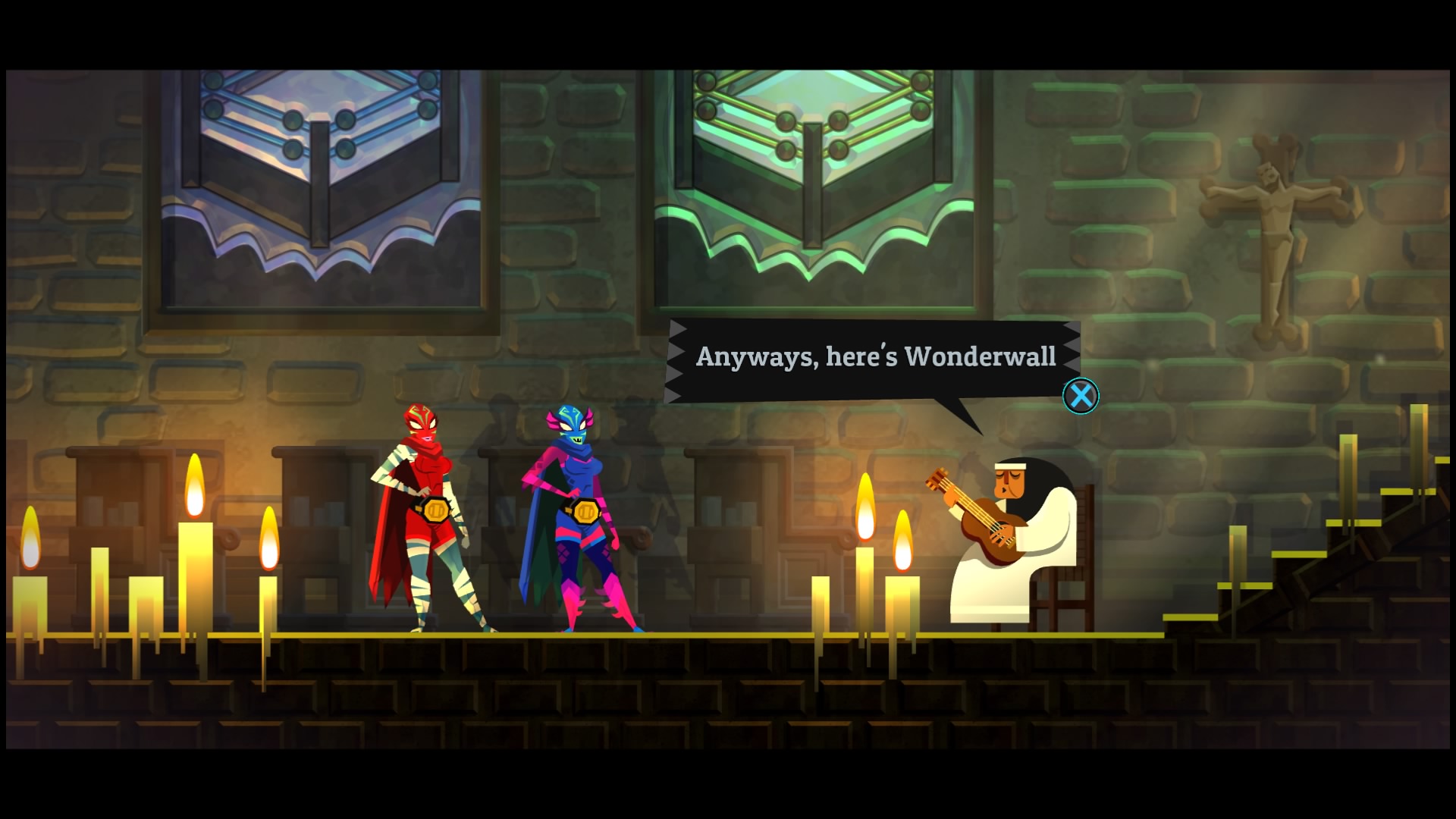
Guacamelee! 2 blends beat ‘em up style brawls with precision platforming to create something that feels wholly unique to the Guacamelee games. Both of those gameplay elements require you to utilize special moves that you’ll acquire as you progress through the game, but here’s the catch: in both cases they’re the same moves. All the familiar favorites (Rooster Uppercut, Dash-Punch, KO Headbutt, and Frog Slam) return for the sequel, and each of them serve a particular purpose. When battling foes with shields, Juan must first break them by using the move that matches with the shield color (e.g., Rooster Uppercut breaks red shields). If you’re attempting to make it through a platforming section, then you’ll use those same moves to help you cross gaps and reach distant platforms. Eventually, you’ll also have to switch between the lands of the living and dead as certain enemies, platforms, walls, and other environmental hazards will only exist in one. All of these elements are introduced slowly throughout the course of the game, but by the end you’ll be combining them in ways that are challenging to execute and very rewarding when you succeed.
While there are a lot of things that carry over from Guacamelee! into Gucamelee! 2, there are a few new things in the sequel to keep it from being just a straight copy/paste with a new story. The biggest changes are the new abilities Juan has for his chicken form. In the previous game, this form was just used as a way to get through narrow spaces. Now, there are not only unique platforming challenges that Juan must overcome using his new chicken abilities, but he can also fight enemies while in this form. In fact, certain enemy encounters will require you to switch between Juan’s human and chicken forms as there will be shields that can only be broken using the new chicken super moves.
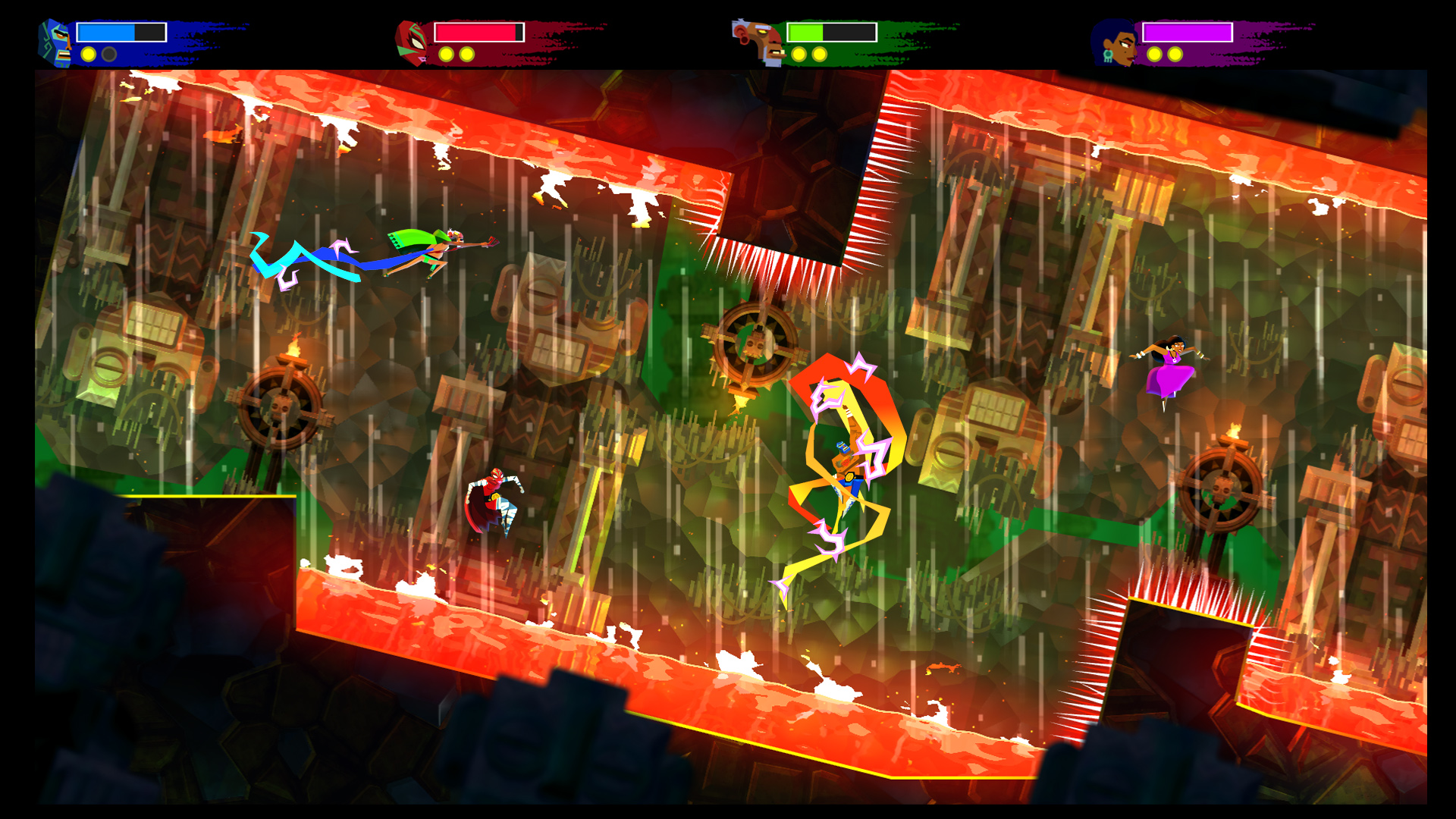
Speaking of those encounters, just like in the first game, most of the enemy encounters in Guacamelee! 2 occur within a limited fighting area. You’ll know you’re about to mix it up when barriers suddenly appear - blocking any possible exits - and the invitation to “LUCHA!” appears on the screen. These fixed battles are specifically designed to either act as a kind of tutorial so you can get acquainted with a new skill you recently acquired, or as kind of challenges where you’ll need to put your fighting and platforming skills to the test. One arena may put enemies on platforms that you can only reach by using your Dash-Punch, while another will take place over a pit of lava with just one platform for safety. These arenas are greatly varied and, late in the game, put all of your skills to the test. They are also “one and done” type situations, which is good as you’ll find yourself running back and forth between zones quite a bit. Backtracking to reach new areas/secrets that were once inaccessible is pretty much a key part of the “Metroidvania” design doctrine, and Guacamelee! 2 embraces that philosophy in a rather weird way.
Some slight spoilers in the next paragraph.
About two-thirds of the way through the game, the world changes. Juan does not stop Salvador from acquiring all the relics necessary to open the way to El Otromundo and as a result horrible black voids open all over the place. These will kill you instantly if even a pixel of your foot comes into contact with them and send you back to the last checkpoint you hit (or the start of the current screen). Dying in this way acts as a kind of “reset” so any enemies you may have killed will respawn and any chests you may have opened you’ll have to get again. It’s annoying and it makes traversing through the world feel like a chore. The good news is this: if you don’t care about finding all the secrets and getting the “good” ending, then this nuisance likely won’t be such a bother.
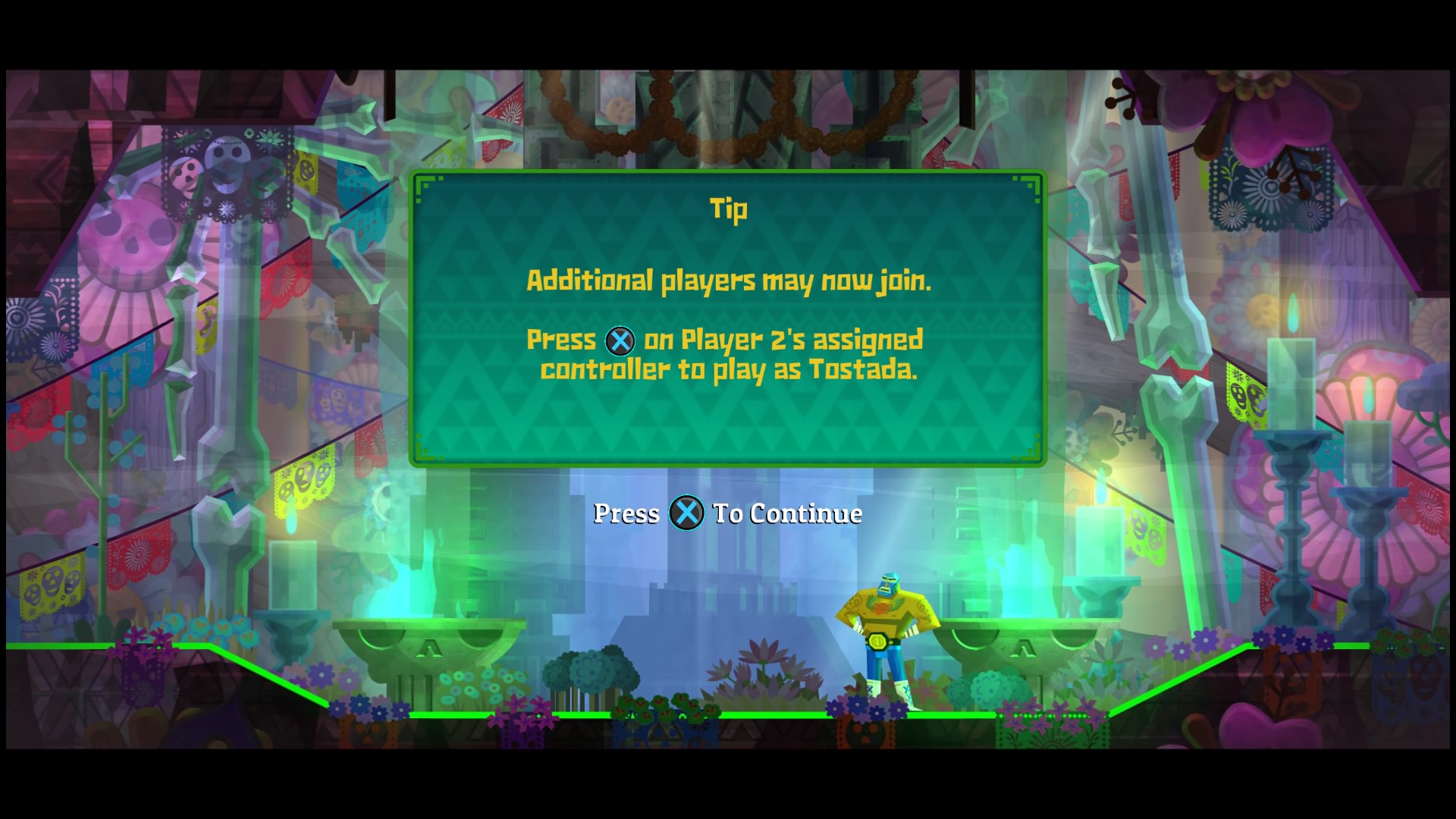
Provided that you’re not running around with a buddy.
Guacamelee! 2’s co-op experience, at its best, can be fun and chaotic. Up to three other players can join you locally at any point once Juan acquires his mask again, which is about 15 to 20 minutes into the game. This means that while player one gets some time to learn some of the controls, everyone else has to be ready to go right away. So there might be a few more player deaths the first couple of minutes when someone joins up if they haven’t played before. Fortunately, player death is handled rather well. Instead of one player dying and causing a reset for everyone, that player has a short respawn counter before they come back as a floating orb. When they get near a living player, that person can press a button to bring the dead player back. Players can also turn into an orb at any time, which is particularly useful for the platforming sections.
Without a doubt, the biggest challenges in Guacamelee! 2 come from these platforming sections. They often require you to string together multiple special moves with precise timing in order to clear them. The more devious ones will not only require you to execute special move after special move, but also switch back and forth between the light and dark dimensions at the same time. When playing the game by yourself, these challenges can be frustrating but ultimately rewarding when you’re able to clear it. When playing with friends, you might lose a friend or two. Trying to have everyone jump, Rooster Uppercut, switch dimensions, and then Dash-Punch at the same time takes a level of coordinated effort that I feel only synchronized swim teams could pull off. What’s more, there is no dynamic split-screen or any split-screen functionality whatsoever, so rather than shift and follow “player 1” like it does when playing solo, the game tries to keep everyone on screen, which can lead to players going off the edges and not able to see what’s happening.
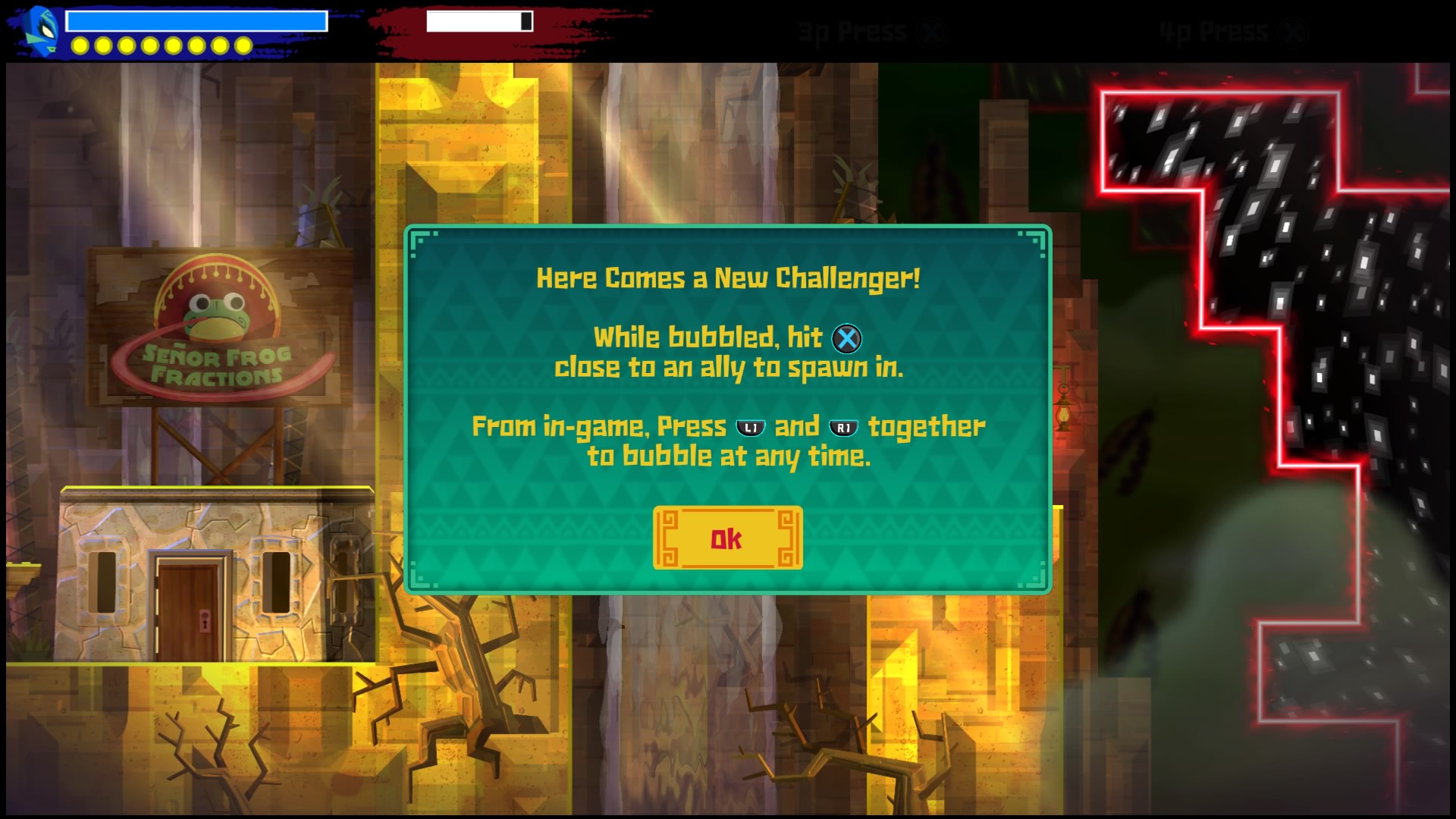
So, the better approach is for the one player that’s good at platforming to clear these sections while everyone else turns into an orb and waits for them on the other side. This will get you clear of these challenges without breaking up any friendships, but it may also leave a few players wondering what they’re even contributing. Considering at least 60% of the game is platforming, too, that’s a lot of time spent by others not playing the game and can lead to the whole experience feeling rather pointless. Fortunately, the remaining chunk of Guacamelee! 2 is all about those arena fights and that is where the co-op feels best.
While the previously discussed enemy encounter arenas can feel like challenges/puzzles in single-player, when playing with friends, they often feel like all-out brawls. Players all learn the special moves at the same time so fists, feet, and heads are flying constantly. You might Dash-Punch a group of enemies across the arena to where your partner is standing and she uses the KO Headbutt to put them down for the count. Another nice feature is that players can individually shift their characters between the land of the living and the dead, so when you’re facing a group of enemies that are split between the two, you can also split up your co-op team to fight them.
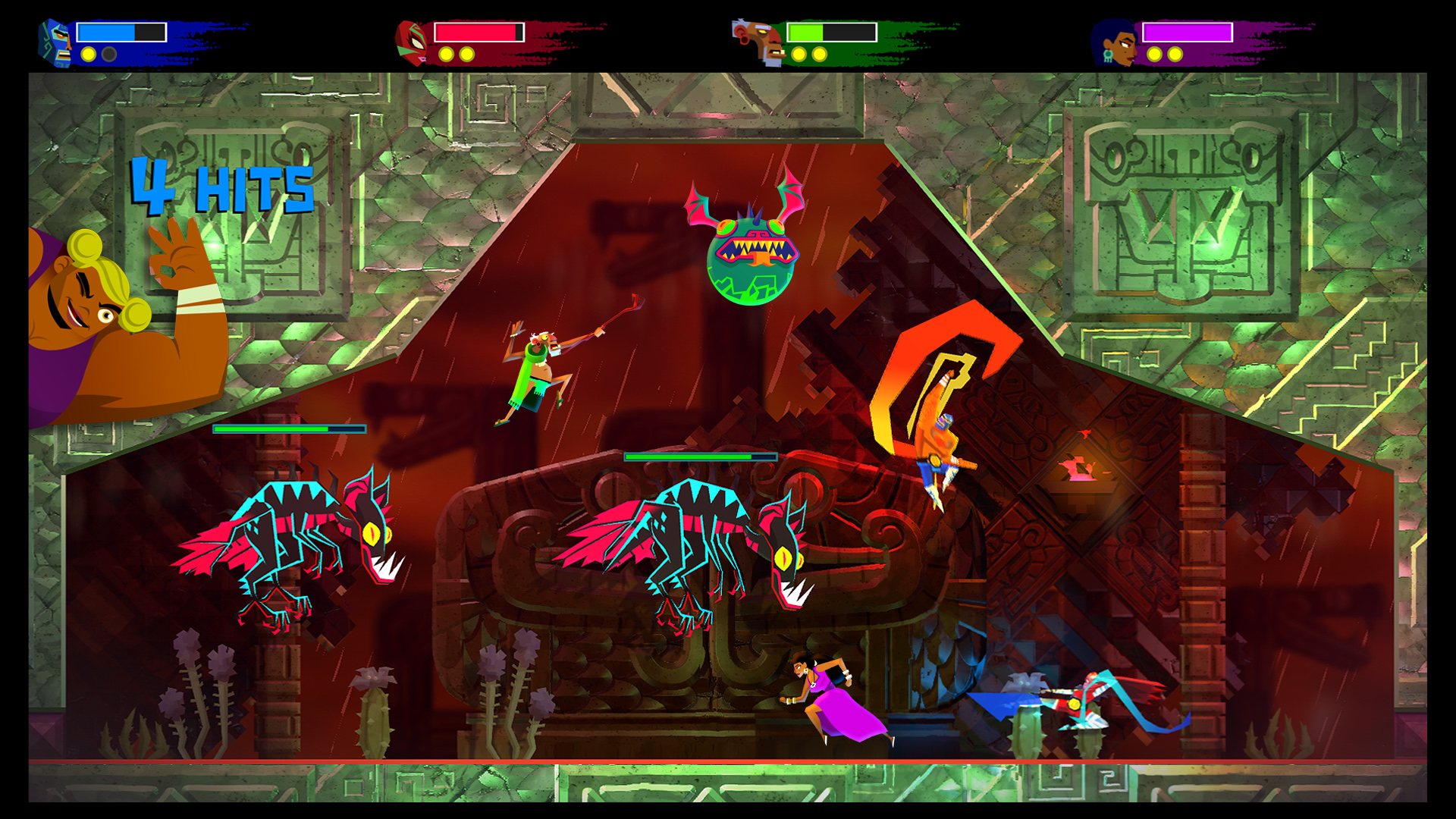
Guacamelee! 2 is every bit as good as the first game; its combat/platforming mechanics strike the right balance between “easy to use” and “hard to master,” if you fail a challenge you can try again right away, and failure, usually, feels like you executed poorly instead of something with the game. It is, in short, “more of the same.” However, as I played more, and particularly as I got into the latter half of the game, I couldn’t shake the feeling that I have done all this before and I don’t think “more” is what I really wanted from a sequel. Same world, same characters, same moves, sure, but where’s the part that mixes things up and makes it feel like something new? On top of that, the co-op experience shifts so rapidly between fun and “let me know when I can play again” that it feels like it might have been better left out altogether. The next time I wish for more of something good, Gucamelee! 2 will remind me to be a little more careful.
The Co-Optimus Co-Op Review of Guacamelee! 2 is based on the PlayStation 4 version of the game. A code was provided by the developer for review purposes.
Verdict
Co-Op Score
Overall
The Co-Op Experience: Four player local, drop-in/drop-out co-op is supported throughout the campaign. Friends can jump in at any Four player local, drop-in/drop-out co-op is supported in the campaign once the first player reaches a certain part about 15 to 20 minutes into it. Friends can jump in at any time after that to help out! The difficulty of enemies will scale to keep things challenging as players drop in and out.
Co-Optimus game reviews focus on the cooperative experience of a game, our final score graphic represents this experience along with an average score for the game overall. For an explanation of our scores please check our Review Score Explanation Guide.
